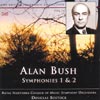Bush, A Symphonies Nos 1 and 2
A political composer bangs the drum
View record and artist detailsRecord and Artist Details
Composer or Director: Alan (Dudley) Bush
Genre:
Orchestral
Label: Classico
Magazine Review Date: 13/2004
Media Format: CD or Download
Media Runtime: 72
Mastering:
Stereo
DDD
Catalogue Number: CLASSCD484

Tracks:
| Composition | Artist Credit |
|---|---|
| Symphony No 1 |
Alan (Dudley) Bush, Composer
Alan (Dudley) Bush, Composer Douglas Bostock, Conductor Royal Northern College of Music Symphony Orchestra |
| Symphony No 2, 'Nottingham' |
Alan (Dudley) Bush, Composer
Alan (Dudley) Bush, Composer Douglas Bostock, Conductor Royal Northern College of Music Symphony Orchestra |
Author: Ivan March
As an admirer of Alan Bush’s chamber music, I cannot feel so enthusiastic about his first two symphonies, and certainly not because of any political prejudice. Although the First was written during the early war years, its restless, brooding character is more concerned with the ‘class conflicts’ of British society, as observed through the eyes of a communist believer. The first movement has a tone row, but the music never loses its tonal basis. A sombre Prologue evolves into a ‘Dance of Death’ to which ‘capitalist policy has brought the peoples of the world’. Ironically, its Shostakovich-like musical character has more in common with the consequences of the Stalinist regime. The brooding slow movement produces a passionate, protesting climax and a coda of impotent rage. The finale is aggressively cheerful, supposedly representing communist dynamism but also apparently associated with Marshall Tito, ‘Defender of Peace’.
Nottingham, the Second Symphony (1949) is mellower. Bush responded to the infamous Zhdanov doctrine of 1948 to write music of a ‘national character’ with more direct popular appeal. The result is more of a suite and, in my view, over-extended. The first movement, ‘Sherwood Forest’, is almost like film music; the slow movement (‘Clifton Grove’) suggests the broad flow of the River Trent. The Scherzo (‘Castle Rock’) includes a passacaglia and a fugue, but it fails to charm the ear. ‘Goose Fair’, the finale, is colourfully scored, again with Shostakovich influences.
I am sorry not to be able to be more enthu-siastic about these symphonies, for Classico is to be congratulated on its enterprise in making them available, and the admirable playing of the excellent Royal Northern College of Music Symphony Orchestra under Douglas Bostock is as persuasive as it could be. The recording, too, is excellent.
Nottingham, the Second Symphony (1949) is mellower. Bush responded to the infamous Zhdanov doctrine of 1948 to write music of a ‘national character’ with more direct popular appeal. The result is more of a suite and, in my view, over-extended. The first movement, ‘Sherwood Forest’, is almost like film music; the slow movement (‘Clifton Grove’) suggests the broad flow of the River Trent. The Scherzo (‘Castle Rock’) includes a passacaglia and a fugue, but it fails to charm the ear. ‘Goose Fair’, the finale, is colourfully scored, again with Shostakovich influences.
I am sorry not to be able to be more enthu-siastic about these symphonies, for Classico is to be congratulated on its enterprise in making them available, and the admirable playing of the excellent Royal Northern College of Music Symphony Orchestra under Douglas Bostock is as persuasive as it could be. The recording, too, is excellent.
Discover the world's largest classical music catalogue with Presto Music.

Gramophone Digital Club
- Digital Edition
- Digital Archive
- Reviews Database
- Full website access
From £8.75 / month
Subscribe
Gramophone Full Club
- Print Edition
- Digital Edition
- Digital Archive
- Reviews Database
- Full website access
From £11.00 / month
Subscribe
If you are a library, university or other organisation that would be interested in an institutional subscription to Gramophone please click here for further information.




